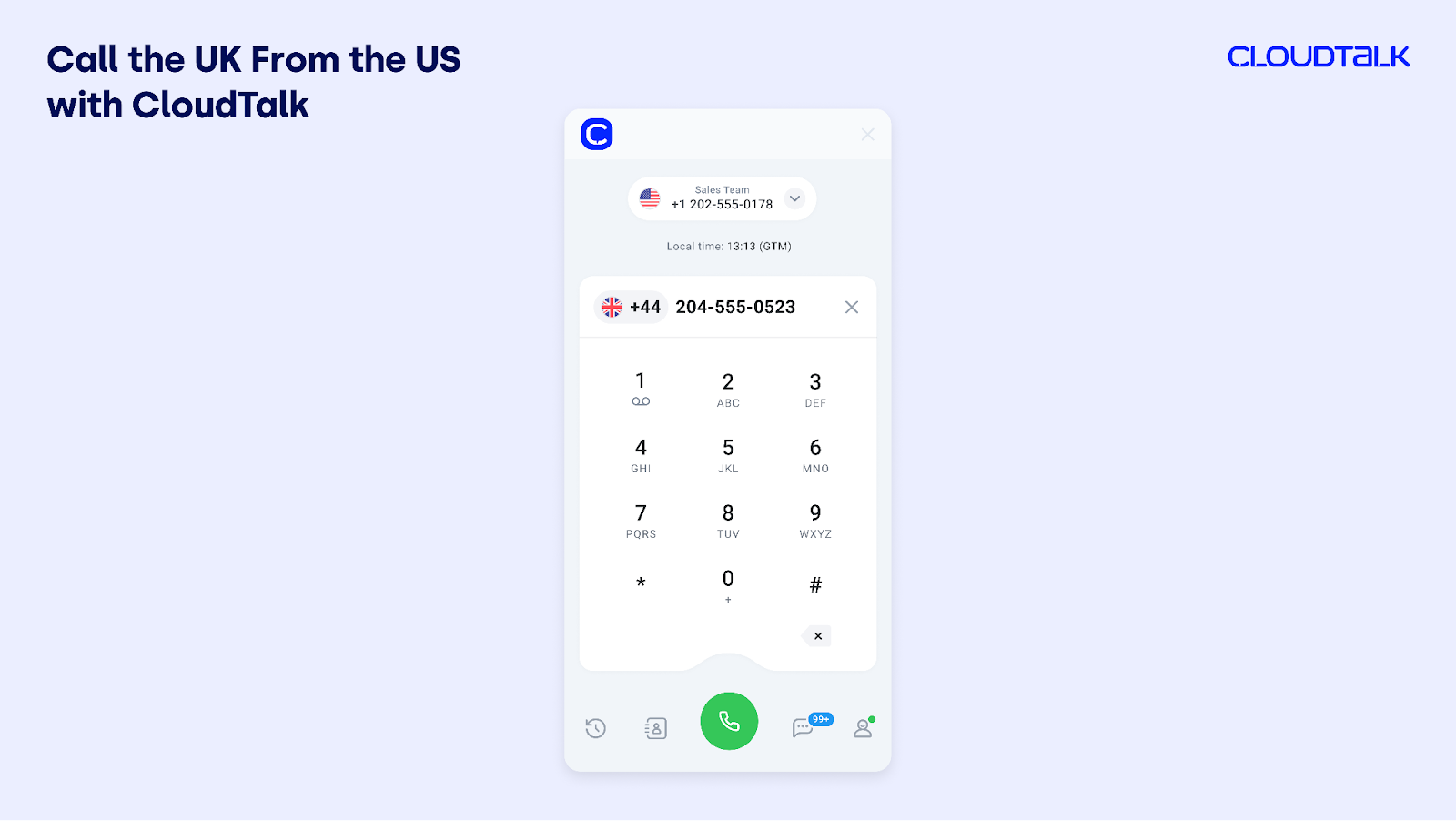In a contact center, every call starts with a number—and choosing the right one can lead to greater trust and higher response rates, while the other could result in missed opportunities.
In this article, we’ll break down how toll-free numbers can make you sound like a nationwide operation, how local numbers can make you feel like the friendly neighbor next door—and how choosing strategically is one of those small, industry-tested moves that can lead to big performance gains.
Key Takeaways
-
Your number choice shapes perception and performance. The right toll-free vs local number strategy can boost trust, increase answer rates, and align with your business goals—whether that means national reach or local credibility.
-
Both have clear strengths and limits. Understanding the difference between toll-free and local numbers helps you match the right option to your audience’s needs, from cost-free nationwide calls to hyper-targeted local presence.
-
You don’t have to choose just one. Many businesses benefit from combining toll-free vs local options, giving them the flexibility to scale nationally while maintaining a strong local connection.
Whether you need toll-free or local numbers, CloudTalk has your back
Local Number vs Toll-Free: Which One Is Better?
Here’s the thing—“better” depends on what you actually need. That’s not a cop-out, it’s just the truth. A local number gives you instant hometown credibility. You look like you’re right there in the neighborhood, even if you’re calling from three states away.
It’s personal. Relatable. Kind of like when your favorite coffee shop knows your order before you say it.
A toll free number does the opposite—it shouts, “We’re open for business anywhere!” It’s perfect for building a national (or even international) presence and making it easy for customers to call you without worrying about the cost. Plus, they have a certain retro allure—think ‘1-800-FLOWERS’.
So ask yourself, are you trying to win over locals, or are you looking to expand your business across state and international borders? And if you want both? The good news is you don’t have to lock yourself into one camp or the other in the toll free number vs local number debate.
Many businesses use both, pairing the national reach of toll-free with the community connection of local. That’s how you get the best of both worlds—and give your customers more ways to connect on their terms.
Ready to see how easy it is to set up either (or both) in minutes?
What Are Local Phone Numbers?
A local phone number is tied to a specific geographic area code—think (415) for San Francisco or (305) for Miami. When someone sees it pop up on their caller ID, it signals, “I’m from your neck of the woods.”
That familiarity can boost trust and increase the odds that your call actually gets answered…in fact, people are 20% more likely to answer the phone if it’s a local area code². That means more conversations with potential customers, higher response rates, and a stronger chance to convert calls.
Unlike a toll-free number, local numbers don’t cover the entire country. They’re designed to make you feel close, even if you’re calling from halfway across the world. And with modern VoIP tools, like a virtual local phone number, you can instantly secure numbers from multiple regions —without renting office space in each one.
So, in the toll-free vs. local conversation, local is the “friendly neighbor” option—personal, targeted, and often more approachable.
To get a clearer idea of whether local phone numbers are right for you, let’s break down their main advantages and disadvantages.
| Pros | Cons |
|---|---|
| Builds immediate trust with customers in the same area code. | Limited to one geographic region unless you purchase multiple numbers. |
| Higher call answer rates from local recipients. | May not project a national or international presence. |
| Cost-effective, especially for regional businesses. | Customers outside your area code may hesitate to pick up. |
| Easy to set up with cloud-based providers like CloudTalk. | Scaling across regions means managing more than one number. |
| Flexibility to add multiple area codes for targeted outreach. | Requires strategic planning for businesses targeting wide markets. |
How to Set Up a Local Phone Number
Setting up a local number used to mean wrangling with the phone company, signing papers, and waiting for someone to install an actual line. Now? It’s closer to ordering takeout.
With a VoIP provider like CloudTalk, you can pick a city, choose an area code, and be making calls in minutes—without ever touching a screwdriver.
Here’s how it works:
1. Choose your provider
Select a virtual local phone number service that offers numbers in your target region. CloudTalk has options in 160+ countries, so you can go as local or as global as you want.
2. Select your area code
Pick the area code that matches your customers’ location. This is where that higher answer rate comes in—customers see a familiar number and are more likely to answer.
3. Add call routing & features
Set up routing so incoming calls go to the right person or team. With CloudTalk, you can also layer on features like call recording, IVR menus, and analytics from day one.
4. Test before you launch
Make a few trial calls to check sound quality, routing, and caller ID display.
5. Go live
Start using your local number in outbound calls, marketing materials, and your website’s “Contact” page. Track answer rates and feedback to see the impact.
Pro Tip
Choose from hundreds of phone numbers with CloudTalk
What Are Toll-Free Numbers?
A toll-free number is exactly what it sounds like—free for the person calling. Instead of your customers footing the bill, you do. It’s the phone equivalent of picking up the check at dinner. Except this dinner is a call from a customer asking about your return policy.
These numbers usually start with prefixes like 800, 888, or 877, and they tell your audience, “We’re a real operation. We’re everywhere. And yes, we can afford it.” For decades, toll-free was the gold standard for any business that wanted a national presence.
Even now, in the age of virtual local phone numbers, a toll-free number still feels more official to many—like you might also have a boardroom and a guy named Carl in accounting.
And thanks to cloud providers, setting one up is not the bureaucratic nightmare it used to be. You can pick a number, add features like IVR menus and call routing, and start taking calls without ever having to sit on hold with a telecom company.
| Pros | Cons |
|---|---|
| Projects a national or international presence instantly. | Less personal — can feel distant or corporate. |
| Free for customers to call, boosting accessibility. | Caller ID recognition may be lower in some regions. |
| Easy to remember, especially with vanity numbers (e.g., 1-800-FLOWERS). | Some audiences prefer the familiarity of a local area code. |
| Works well for marketing campaigns targeting wide geographies. | International calling costs may still apply for overseas customers. |
| Scales easily as your business grows across markets. | Risk of spam calls or misuse if widely publicized. |
Pro Tip
How to Install a Toll-Free Phone Number
Getting a toll-free number used to mean filling out forms, waiting weeks, and hoping some anonymous phone company bureaucrat didn’t lose your paperwork in a filing cabinet from 1978. Now? You can get your number while waiting for your sugar-free oatmilk latte.
Here’s how:
1. Pick your provider
Find a reliable toll-free number provider that offers the features you need—things like call routing, analytics, and integrations with your CRM.
2. Choose your prefix
800, 888, 877… the classics are still available, but you can also opt for newer prefixes if your preferred number’s already taken. Vanity numbers are memorable, but not mandatory.
3. Configure your features
Decide how incoming calls should be handled. With CloudTalk, you can add an IVR menu, route calls to specific teams, record calls for training, and connect everything to your existing tools—all in one dashboard.
4. Test before launch
Make a few test calls to confirm your caller ID displays correctly, the routing works, and the sound quality is crystal clear. This is your dress rehearsal before opening night.
5. Start taking calls
Once everything’s set, publish your number on your website, social media, and marketing materials. Sit back and let your nationwide presence do the talking.
See how easy it is to set up your toll-free number with CloudTalk.
Key Differences Between Local and Toll-Free Numbers
Local numbers tie you to a specific geographic area code, for that sugar-borrowing-neighborly feel. Toll-free numbers, on the other hand, are not bound by lines on a map—they’re reachable nationwide (or beyond) without charging the caller.
Both can boost your business, but they serve different purposes: local for trust and familiarity, toll-free for reach and credibility.
| Feature | Local Number | Toll-Free Number |
|---|---|---|
| Coverage | Tied to a specific geographic area code. | Works nationally and often internationally. |
| Customer Perception | Feels personal, local, and approachable. | Feels established, professional, and large-scale. |
| Cost to Caller | May incur charges for out-of-area calls. | Always free for the caller within the coverage area. |
| Best For | Regional marketing, community trust, higher local answer rates. | National campaigns, brand recognition, customer support hotlines. |
| Setup Speed | Instant with a virtual local phone number. | Instant with a toll free number provider. |
| Scalability | Requires additional numbers for other regions. | One number can cover wide or multiple regions. |
| Example | (212) for NYC, (415) for San Francisco. | 1-800, 888, 877 prefixes. |
Local vs. Toll-Free Numbers: Which Is Best for Your Business?
Ah yes, the age-old question: should your business sound like the aforementioned friendly neighbor who will lend you the cup of sugar, or the polished corporation that owns the sugar factory?
Both are great! It simply depends your business objectives. Let’s look at some considerations so you can decide which is best for you.
When to Use a Local Number
Go local when you want to:
-
Build instant trust by looking like you’re just around the corner.
-
Get higher pick-up rates from people who would otherwise ghost unknown numbers.
-
Keep your marketing hyper-targeted—perfect for realtors, local services, and political campaigns that want you to know they’re from here.
-
Give each branch, franchise, or location its own identity.
When to Use a Toll-Free Number
Go toll-free when you want to:
-
Be reachable across regions without customers paying a cent.
-
Project big-business credibility, even if your office is still in the corner of your living room.
-
Run nationwide campaigns where one central number just makes life easier.
-
Create a vanity number people actually remember (1-800-FLOWERS, 1-888-BEST-CAKE).
Mix local and toll-free numbers so your business can be everywhere and next door.
Should Your Business Have Both Local and Toll-Free Numbers?
Short answer: yes. Long answer: yessssss.
Because here’s the thing—a local number says “we’re part of your community” while a toll free number says “we can help anyone, anywhere.” And if you’re an SMB, then you likely need both.
Local numbers give you that warm, approachable, “call us if you need a hand” energy. Toll-free numbers give you reach, consistency, and the ability to run national campaigns without looking like you’re just cold-calling people from a single zip code.
Think of it like footwear: local is your comfy sneakers, toll-free is your nice dress shoes. You could wear either all the time… but honestly, why would you, when switching is so easy and having both makes you look put together in every situation?
Discover how easy it is to combine toll free and local.
Recommended Articles
Toll-Free vs Local Numbers—The Choice is Yours and You Can’t Go Wrong
Here’s the thing: toll-free vs local numbers isn’t a fight about Batman vs. Superman. It’s more like Batman and Superman deciding who’s picking up takeout. Both are good, both get the job done, both have their fan clubs.
A local number says “Hey, we’re part of your neighborhood.” A toll free number says “We have a neighborhood… and it’s called America.” One builds trust with your immediate community, the other makes you sound like a national force. And honestly, if your business can swing it, having both is the smart play.
Because in the end, your number should match your goals. Want more regional loyalty? Local. Want broad reach without customers paying to call? Toll-free. Want to cover all your bases? Mix and match like you’re building the world’s most boring—but highly effective—ice cream sundae.
And if you’re going to do this right, do it with a platform that actually makes your numbers work for you. CloudTalk gives you voice, messaging, and cross-platform magic so your remote teams look like they have it together… even if you’re still working out of your kitchen table next to the cat.
Pick your vibe, pick your number. Then start with CloudTalk’s Local Numbers and watch as your answer rates start climbing.















